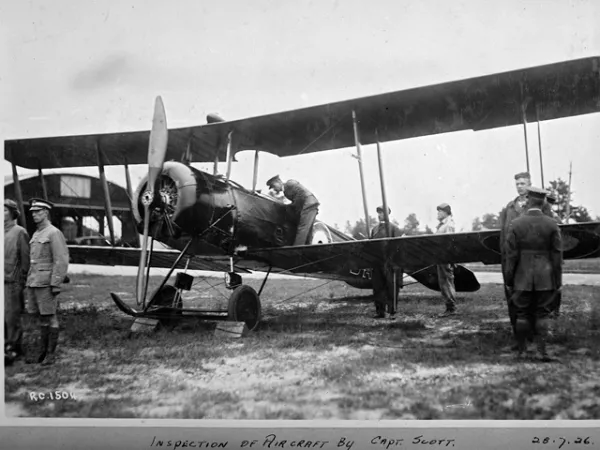
Highlights:
- A two-seater biplane designed in 1913 in the U.K. by A.V. Roe and Company Limited (Avro)
- Served in reconnaissance and anti-Zeppelin patrols during the First World War, but was later developed as a trainer aircraft
- Selected in 1920 as the standard trainer for the Canadian Air Force, remaining in service until 1928; a postwar version (Avro 504N) was built in Canada and served with the RCAF until 1930
- A civilian Avro 504 made one of the first commercial passenger bush flights in Canada: two passengers seated in an enlarged front cockpit were flown from Winnipeg to Le Pas in October 1920
- First flight was in September 1913 (Avro 504)
Image Gallery:
History:
The Avro 504 series was used early in First World War for reconnaissance and anti-Zeppelin patrols, but was subsequently developed as a trainer. A Canadian version was in production just as the war ended, but only two were built. In 1920, the Avro 504K was selected as the standard trainer for the Canadian Air Force and remained in service until 1928 when six were sold for civilian use.
A civil Avro 504K is credited with one of the first commercial passenger flights into the Canadian bush on 15 to 17 October, 1920. Two passengers seated in an enlarged front cockpit were flown from Winnipeg to Le Pas. An ex-Air Force 504 made the first winter flight to James Bay in 1922.
The Turnbull variable-pitch propeller was tested on an Avro 504 at Camp Borden, Ontario on 29 June, 1927.
Current Location:
Reserve Hangar, Canada Aviation and Space Museum
Provenance:
Transfer from CAF
This Avro 504K was manufactured in 1918 by A.V. Roe and Company Limited (Avro) in the United Kingdom. It passed through the hands of several American owners, including James H. "Cole" Palen of Rhinebeck, New York, who purchased it from the Roosevelt Field Historical Aviation Museum in 1951 and used it in flying exhibitions.
The RCAF purchased the aircraft from Palen in 1961 and later restored it. It was used in RCAF air demonstrations in 1967 before it was retired to the RCAF's historic aircraft collection. Transferred to the Museum in 1968, it is one of several rotary-engine aircraft in the collection.
Technical Information:
| Wing Span | 11 m (36 ft) |
| Length | 9 m (29 ft 5 in) |
| Height | 3.2 m (10 ft 5 in) |
| Weight, Empty | 560 kg (1,230 lb) |
| Weight, Gross | 830 kg (1,830 lb) |
| Cruising Speed | 120 km/h (75 mph) |
| Max Speed | 153 km/h (95 mph) |
| Rate of Climb | 1,070 m (3,500 ft) / 5 min |
| Service Ceiling | 4,877 m (16,000 ft) |
| Range | 400 km (250 mi) |
| Crew | two or three |
| Power Plant | one Clerget 9B, 130-hp, rotary engine |
- View all the collection highlights at the Canada Aviation and Space Museum
- View other collection highlights related to Aviation




